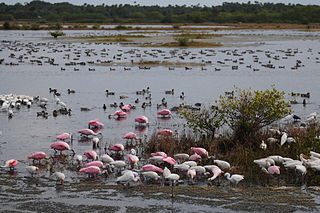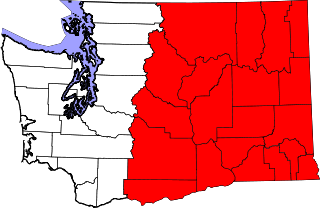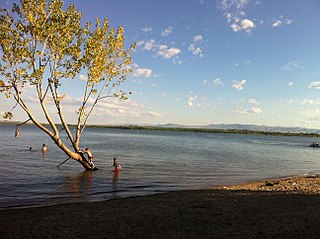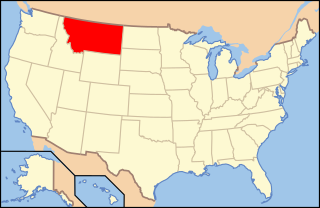Related Research Articles

Merritt Island National Wildlife Refuge is a 140,000-acre (57,000 ha) U.S. National Wildlife Refuge (NWR) on the Atlantic coast of Florida's largest barrier island. NASA's Kennedy Space Center and visitor complex are also situated on the island and NASA can restrict access to the refuge based on its operational needs.

Eastern Washington is the region of the U.S. state of Washington located east of the Cascade Range. It contains the city of Spokane, the Tri-Cities, the Columbia River and the Grand Coulee Dam, the Hanford Nuclear Reservation and the fertile farmlands of the Yakima Valley and the Palouse. Unlike in Western Washington, the climate is dry, including some desert environments.

Bear Lake State Park is a public recreation area bordering the north and eastern shores of Bear Lake in the southeast corner of Bear Lake County, Idaho, near the Utah and Wyoming state lines. The state park sits across the lake from St. Charles and is fifteen miles (24 km) south of Montpelier. Bear Lake National Wildlife Refuge lies adjacent to the park's north unit.

Selawik National Wildlife Refuge in northwest Alaska in the Waring Mountains was officially established in 1980 with the passage of the Alaska National Interest Lands Conservation Act (ANILCA).

Benton Lake National Wildlife Refuge is a 12,459-acre (5,042 ha) National Wildlife Refuge (NWR) in the central part of the U.S. state of Montana.

The Tule Lake National Wildlife Refuge is a National Wildlife Refuge of the United States in northern California near the Oregon border. It covers 39,116 acres (15,830 ha) in the Tule Lake basin. It is part of the Klamath Basin National Wildlife Refuge Complex, and is a crucial part of the Pacific Flyway corridor for migratory birds.

Medicine Lake National Wildlife Refuge is a 31,533-acre (12,761 ha) National Wildlife Refuge located in the northeastern region of the U.S. state of Montana. The refuge is part of the Medicine Lake National Wildlife Refuge Complex which also includes the Northeast Montana Wetland Management District (WMD) and Lamesteer National Wildlife Refuge. Medicine Lake is from the Assiniboine description of the lake, "Bda wauka". The refuge was established in 1935 to protect habitat for various wildlife and especially migratory birds. The refuge is managed by the U.S. Fish and Wildlife Service, an agency of the U.S. Department of the Interior. In 1980, the Medicine Lake Site was designated as a National Natural Landmark by the National Park Service.

The Deer Flat National Wildlife Refuge is an important breeding area for mammals, birds, and other animals. The National Wildlife Refuge is located on land surrounding Lake Lowell, just outside Nampa, Idaho. It serves as a resting and wintering area for birds, including mallards and Canada geese, along the Pacific Flyway and was named a "Globally Important Bird Area" by the American Bird Conservancy.

The Lake Wales Ridge National Wildlife Refuge is part of the United States National Wildlife Refuge (NWR) System, located in four separated areas on the Lake Wales Ridge east of US 27 between Davenport and Sebring in Florida. The 1,194 acre (4.8 km2) refuge was established in 1990, to protect a host of plants and animals. It is also the first to be designated primarily for the preservation of endangered plants, and is not open to the general public. It contains a high proportion of remaining Florida scrub habitat. It is administered as part of the Merritt Island National Wildlife Refuge.

Lake Walcott is a reservoir in south central Idaho in the northwestern United States, impounded by Minidoka Dam. The damming of the Snake River by the Minidoka Project formed the 11,000 acre (45 km2) lake beginning in 1909. Bird Island is an island in the lake. The Idaho parks and recreation website lists many activities including fishing, boating, camping and swimming. The Minidoka National Wildlife Refuge and Lake Walcott State Park adjoin the lake and are major attractions in the region.

The following is an alphabetical list of articles related to the U.S. state of Montana.

The Upper Klamath National Wildlife Refuge is a wildlife refuge in southwestern Klamath County on the shores of Upper Klamath Lake in Oregon. It was established in 1928 and contains some 14,400 acres (5,800 ha) of freshwater marshes. It is accessible only by boat from Rocky Point Resort and Rocky Point boat launch, Malone springs, and a few neighboring ramps. The refuge is part of the Klamath Basin National Wildlife Refuge Complex and is administered along with the other refuges of the complex from common offices in Tulelake, California.

Bear Lake National Wildlife Refuge is located in southeast Idaho, seven miles (11 km) south of Montpelier. Surrounded by mountains, it lies in Bear Lake Valley at an elevation ranging from 5,925 feet (1,806 m) on the marsh to 6,800 feet (2,100 m) on the rocky slopes of Merkley Mountain. The refuge office is located in Montpelier.

Grays Lake National Wildlife Refuge is a National Wildlife Refuge of the United States located in southeastern Idaho. It has the largest hardstem bulrush marsh in North America. Located in a high mountain valley near Soda Springs, the refuge and surrounding mountains offer scenic vistas, wildflowers, and fall foliage displays. Lands adjacent to the 19,400-acre (79 km2) refuge are primarily wet meadows and grasslands. The refuge provides breeding habitat for species of mammals including moose, elk, mule deer, muskrat, badger, and weasel.

Minidoka National Wildlife Refuge is located on the Snake River Plain in south-central Idaho, 12 miles (19 km) northeast of Rupert. It includes about 80 miles (130 km) of shoreline around Lake Walcott, from Minidoka Dam upstream about 25 miles (40 km).

Kern National Wildlife Refuge is a 11,249-acre (45.52 km2) protected area located in the southern portion of California's San Joaquin Valley, 20 miles (32 km) west of the city of Delano. Situated on the southern margin of what was once the largest freshwater wetland complex known as Tulare Lake in the western United States, Kern National Wildlife Refuge provides an optimum wintering habitat for migratory birds with an emphasis on waterfowl and water birds. The wetlands provide habitat for birds as part of the Pacific Flyway.

Lake Walcott State Park is a public recreation area located near the Minidoka Dam six miles (9.7 km) east of Acequia in Minidoka County, Idaho, United States. The state park encompasses 65 acres (26 ha) on the western shore on Lake Walcott, an 8,000-acre (3,200 ha) impoundment of the Snake River. The Minidoka National Wildlife Refuge adjoins the park and the lake. The park's recreational offerings include disc golf, camping, picnicking, boating, fishing, and water sports.